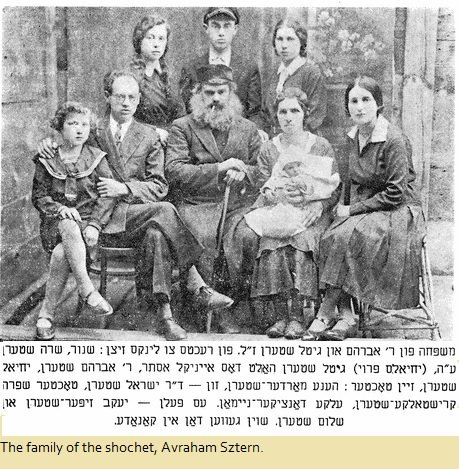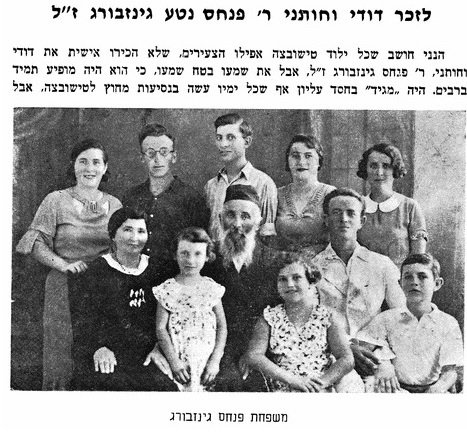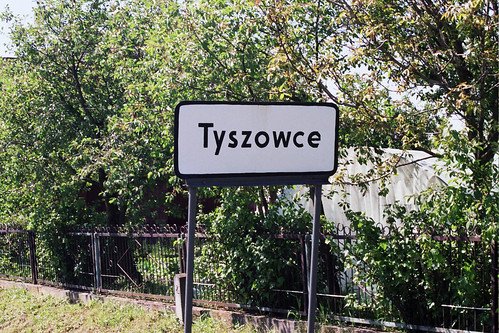Remember Jewish Tyszowce
Pronunciation: Tish-ovstsa or Tish-e-vitz
HISTORY OF JEWISH TYSZOWCE
Tyszowce is a village in Lublin province, near the city of Tomaszow Lubelski. The city was granted municipal rights in 1453. Jewish merchants settled there in the early 16th century, and by the 1630s they actively participated in the fairs at Lublin and L'vov. In 1565 King Sigismund II Augustus granted Jews equal rights and forbade market days to be held on the Sabbath. The Council of Four Lands
sometimes met in Tyszowce and discussed autonomous governance of communities, independent choice of rabbis, guardianship of orphans, marriage arrangements, intercession with the government, and financial support for Jews in Eretz Israel. In 1649 and 1655-57, the Jewish populations suffered from the armies of Czarniecki and Chmielnicki. Jews were living in the party of the city called Ostrow. In 1571, there were 31 Jewish families living in Tyszowce. In 1630, Tyszowce numbered 1,420 people, of whom 280 were Jewish (19%). In 1765, 925 Jews living there paid the poll tax. In 1815 the city was included in Congress Poland, and from 1823-1862 the Russian authorities limited Jewish settlement in the area because of its proximity to the Austrian border. The 732 Jews living there in 1827 comprised 34% of the total population. In 1857 there were 956 Jews (36%) and in 1897-98, there were 851 Jews (85%); in 1921, 2,454 Jews made up slightly more than half of the city population. Between the world wars all the Jewish parties were well represented and there was an active Jewish community life.
Because of the Jewish population, Tyszowce became the largest center of butchery to the east of L'vov. In the 18th century, Jews in the city engaged in trades like shoemaking, pottery, and commerce. In the inter-war period, a cinema was established in Tyszowce by a Jew, Mejer Szek, and a Pole, Kazimierz Sikorski. Mejer Szek also owned a tavern in the town square. Jewish-owned restaurants by Sinai Szek and Jankiel Glik were located at the entrance to the town square, on both sides of the street.
The first records of a wooden synagogue in Tyszowce dates back to 1571. It burnt down in 1717. A masonry synagogue was located on the western side of the town square. On September 13, 1939, the synagogue was destroyed in a fire. In autumn of 1939, the synagogue was blown up by the Nazis. The rubble from the desecrated synagogue was used for road paving (slave labor). The old Jewish cemetery in Tyszowce was set up at the end of the 16th century. It is located in Koscielna Street. The cemetery is surrounded by a brick wall on one side and a wooden fence on the other. During the Holocaust, shooting ditches were formed there. The Nazis took down the brick wall and used the bricks to build a stable for horses. Gravestones were used for pavements and footbridges. Tombstones were also used to pave the road to the nearby town of Laszczow. No tombstones are left at the old cemetery. A preschool was constructed in the area where the cemetery was located after the war. In 1988, a commemorative stone was put in the cemetery to commemorate a well-known rabbi named Ben Josef. The new Jewish cemetery in Tyszowce was built in the late 19th century. It is located outside of the city, about 50 mi. northwest of the road from Tyszowce to Tuczapy. The Nazis devastated the cemetery. Fourteen tombstones have survived, of which the oldest dates to 1884. The tombstones have visible carvings and inscriptions in Hebrew. In 1988, thanks to Dawid Laks and Abraham Borg, a fence was built and the cemetery was renovated. Four matzevahs were erected
and a monument to commemorate the Holocaust victims was erected. The cemetery fence is made of metal spans and there is the Star of David on the gate. Ashes were also brought from the Belzec death camp. Northwest of the synagogue there was a house of learning (Beit Hamidrash), adjoined by a Hasidic shtiebel (small house of prayer). The other shtiebelekh were scattered around the market square. Cheders were also located in the market square. On the banks of the river channel, there was a mikveh (Jewish ritual bath).
The village of Niewirkow near Tyszowce had a population of 20 Jews. The village of Klatwy near Tyszowce may have also had a Jewish population, but the number is not known.
THE HOLOCAUST IN TYSZOWCE
On the outbreak of World War II, there were about 3,800 Jews in Tyszowce. In September, 1939 the Red Army entered the city but withdrew after a short time, in accord with the Soviet-German agreement on the partition line. About 1,000 Jews left the city for the east with the withdrawing Red Army. The Germans army occupied the city at the beginning of October 1939. The Nazis established a Judenrat composed of 10 people in the spring of 1940, headed by Zelig Cukier. The Nazis also set up the Jewish police, headed by Mejer Szek. About 150 Tyszowce Jews were deported to the Zamosc labor camp. They worked on reinforcing border fortifications near Lubycza Krolewska. Jews from Warsaw, Otwock and Lublin were brought to Tyszowce by the Nazis to engage in forced labor on roads and river control. The Nazi head of the military police in the city, Ernst Schultz, was unbearably cruel toward the Jewish population.
In fall of 1940, the Nazis set up a forced labor camp in Tyszowce. Jews were used as labor on the Huczwa River. As a result of poor sanitary conditions in the labor camp, diseases rose up, including a typhus epidemic. The camp was closed in fall 1941. An article exists which details this forced labor -- focusing on Tyszowce and including a photo. Many other labour camps forcing Jews to work existed in the Lublin district.
In Tyszowce, on the night of April 16, 1942, the Nazis launched a mass execution of the Jews of the city. They were brought to the city square near the former public bath, where several hundred were shot. The Nazis threw the corpses into a huge ditch. In May of 1942 about 1,500 Jews were deported to the Belzec Death Camp and another 800 were sent to the Sobibor Death Camp. Those who tried
to protest were murdered on the spot. A small number of Jews were able to escape to the forests. For the remaining Jews, a ghetto was established in the area between the old arm of the Huczwa River and Zamlynie. About 600 to 1,000 Jews were put there, including several Jews from Czechoslvakia. A new Judenrat was established, headed by Fishlieber (Fiszleber), a German Jew who was cruel towards the local Jewish population and collaborated with the Nazis. Near to the ghetto was a municipal detention house in which the Nazis kept several dozen Jews for weeks without any food.
According to historian Emmanuel Ringelblum, who was murdered in Warsaw in 1944, "150 Jews were burned alive in the local synagogue in Tiszowce." It is unclear when this sad event took place. In October of 1942, the ghetto was liquidated. Of those who had survived -- around 92 Jews -- 70 were sent to Belzec Death Camp and the other 22 were shot in the ghetto. The Jews of Tyszowce were no more.
The head Nazi in Tyszowce and nearby Komarow was named Ernst Heinrich Schulz (Schultz). Local collaborators -- identified by Jewish survivors -- included: Stefan Lepecki, Jan Bednarek, Anna Bednarek, Leon Jablonski, Wladyslaw Machomet and Jan Zielinski.
A handful of Jews from Komarow and Tyszowce managed to organize a resistance movement by creating a combat unit in the woods between the town towns. They gathered a few weapons, bought from Poles, and carried out attacks on the Germans. Among the fighters were Chaja Helfman (killed), Yeshayahu Sztengel (killed) -- who later took part in the Warsaw ghetto uprising, and Tzvi Finger.
In 1937, American Phillip Putter returned to his hometown of Tishevits with his 8 mm camera to film street scenes and daily life. In 1982, the YIVO Institute for Jewish Research invited two of Philip's former neighbors in Tyszowce, Esther Kizel (Kisel) and Paya Rosenzweig, to view his film and to talk about the people that appear in it. The film is available online via YIVO.
Please review the site content below. Zachor - We Remember.
------------------------------------------------------------------------
[Surnames and Researchers] [History] [Tyszowce Yizkor Book (Hebrew)]
[Unidentified Photos] [YIVO Video Archives: Tyszowce]
[Political/Cultural Life] [Wikipedia - Tyszowce] [List of Martyrs]
[Cemeteries] [Old Synagogue] [List of Martyrs 2]
[Yahad-in-Unum Investigation in Tyszowce, 2012]
[Pinkas Tishevits - Yizkor Book (readable online)]
------------------------------------------------------------------------
LINKS
Join the Tyszowce group on Facebook!
City of Tyszowce:
Article: Ernst Schulz, Nazi of Komarow/Tyszowce
Article: Moshe Laks, Holocaust Survivor
"A Kheyder in Tyszowce" by Yekiel Shtern
Alphabetical Register of Tyszowce Victims
Belzec Death Camp
Excerpt on Tyszowce from a book by David Roskies
First Tishiritzer Benevolent Society - Staten Island, New York
History of Tyszowce Jewish Community, 16th-18th Centuries
International Jewish Cemetery Project: Tyszowce
Isaac Beshevis Singer's Tribute to Tyszowce
Old Tyszowce Pictures
ORDER Pinkas Tishivits (or order from another location)
Pinkas Hakehillot Polin: Tyszowce
The Shtetl Book by Diane Roskies (includes Tyszowce)
Tyszowce Jewish Discussion List
Tyszowce Yizkor Books Online (no English)
Tyszowce Yizkor Book Necrology
Families of Tyszowce:
Adler family
Borg famly
Gelerter family
Golomb family
Rajs family
Szerer family
Zylberman family
Rabbis of Tyszowce:
Avraham David Ber Moshe, rabbi until 1746
Tzvi Hersz Baschko (surname also listed as Zamosc), rabbi until 1771
Natan Nute HaKohen Szapira, 1773
Zachariah Mendel Yaskis (Yaskes), 18th century
Yehuda Leibush Segal Ettinger, 18th century
Abraham Jakob Gelernter and his son Dawid, 1807-1814
Jakob Eichenbaum, 1815
Abraham Braff, mid-19th century
Dawid Wahl, 1866
Zalman Kaplan
Moszek Icek Wielwelewicz, 1881
Yoel Steinschreiber
Shimshon Mordechai Josef Glanc
Yehuda Leibus HaKohen Adamszik
Moshe Yehuda Berger, cantor
Yehoshua Flaks, cantor
Judka Lejb HaCohen Adamschik (Adamshik)
Lejb Aryeh Glanc, rabbi up to the Holocaust
Notable People
Rabbi Tzi Hirsch Baschko
Sender Sidney Licht
Adolphe Milich
Arnold Slucki (Aron Kreiner)
Yankel Shtern (Jacob Ziper)
Survivors of Tyszowce:
Michael Bergman
Mala Biterman Lader
Chawa Biterman Polik
Abraham Borg
Dora Drescher
Izaak Folk
Yaakov Folk (Polik)
Sara Folk Nussbaum
Szymon Frydlinski
Roza Garber (liberated from Bergen-Belsen, 1945)
Icek "Izaak" Gelber (liberated from Dachau, 1945)
Michal Glowinski
Arie Gutheit
Ellen Hamer Herszenson (testimony)
Esther Kizel
Shmuel Knobel
Ephraim Koppersztejn
Shifra Krishtalka
David Laks
Moshe Laks (Morris Lax)
Pinchas Landau
Henia Dwora Marder
Zvi Naor (video testimony)
Moshe Peled
Anna Rozen
Paya Cwilich Rosenzweig
Lejzor Rub
Moshe Sachar
Dov Szpic
Israel Hirsch Sztern
Moshe Umfasung
Sheila Waichman
Moshe Zimary
Pinchus Zinger
Righteous Gentiles:
- Jozef and Marianna Holtzer employed 12 Jews at Celestynow near Rachanie. The 14 of them were murdered on November 2, 1942.
Genealogy:
Jewish Records Indexing Poland - Tyszowce
Jewish Vital Records in the Polish State Archives
Remember Your Family:
Central Judaica Database - Museum of History of Polish Jews
Grandchildren of Holocaust Survivors on Facebook
Guide to the YIVO Archives
Holocaust News/Events from Generations of the Shoah Int'l
Holocaust Survivors and Victims Database
JewishGen Family Finder
JewishGen Holocaust Database
JRI-Poland: Search for Your Family
Museum of History of Polish Jews Introduction
Yad Vashem: Search for Your Family
Yad Vashem: Submit Names of Your Family Members
Yad Vashem Requests Photos of Shoah Survivors and Families
CONTACTS
U.S.: LublinJewish@gmail.com
Return to Lublin Index











A group of unidentified students in Tyszowce.

